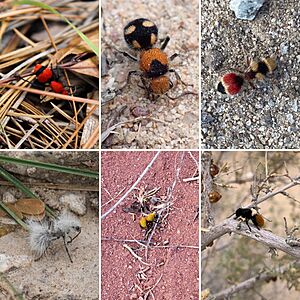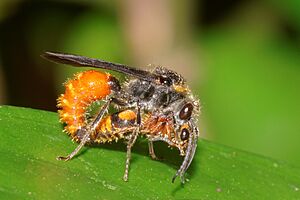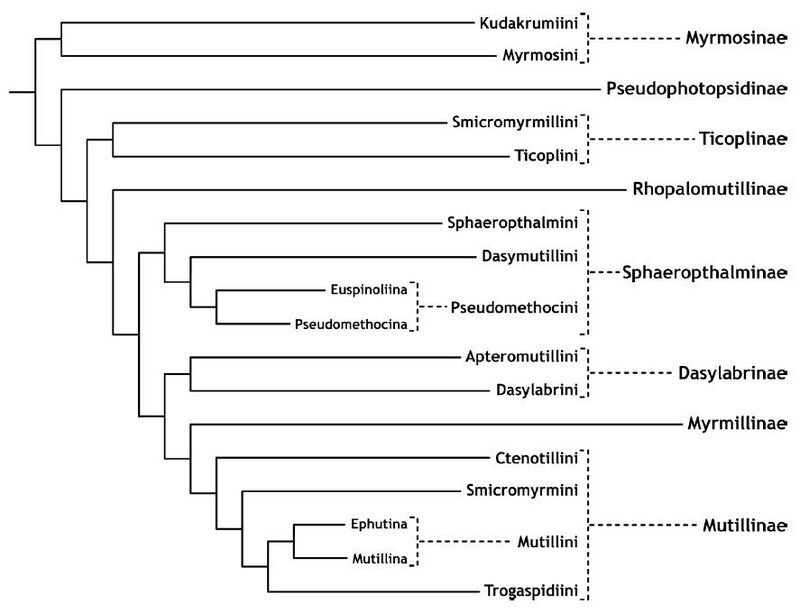Velvet ant facts for kids
Quick facts for kids Velvet ant |
|
|---|---|
 |
|
| Dasymutilla spp. | |
| Scientific classification |
|
| Kingdom: | Animalia |
| Phylum: | Arthropoda |
| Class: | Insecta |
| Order: | Hymenoptera |
| Superfamily: | Pompiloidea |
| Family: | Mutillidae Latreille, 1802 |
| Subfamilies | |
|
Mutillinae |
|
Velvet ants are a group of over 7,000 types of wasps. Their females don't have wings and look like big, furry ants. They get their name "velvet ant" because they look like ants and have thick, soft hair. This hair is often bright red or orange, but it can also be black, white, silver, or gold. Their bright colors warn other animals that they are dangerous.
Velvet ants are famous for their very painful stings. For example, the sting of the Dasymutilla klugii species is rated high on the Schmidt pain index and can hurt for up to 30 minutes. Because of this, some people call the Dasymutilla occidentalis species a "cow killer" or "cow ant." However, velvet ants are not aggressive. They only sting if they feel threatened. Also, their venom is not as strong as that of honey bees or harvester ants. Unlike true ants, velvet ants live alone and do not have complex social groups.
Contents
Where Do Velvet Ants Live?
Velvet ants live all over the world. There are about 230 different groups, or genera, and around 8,000 species worldwide. More than 400 species can be found in the southwestern part of North America.
In North America, velvet ants have eight different groups that look alike and live in specific areas. These groups are part of a huge Müllerian mimicry system. This means that different velvet ant species in the same area have evolved to look similar. This helps them warn predators to stay away. Predators learn to avoid these brightly colored wasps because they know they can sting.
What Do Velvet Ants Look Like?
The outside shell, or exoskeleton, of all velvet ants is very tough. It's so strong that some scientists find it hard to push a steel pin through them. This tough shell helps them get into the nests of their prey. It also helps them keep moisture inside their bodies.
Male and female velvet ants look very different. This is called sexual dimorphism. Male velvet ants have wings, but females do not. Males and females look so unalike that scientists often struggle to tell if they belong to the same species. They can only be sure if they catch them mating. In some species, the male carries the smaller female while they mate.
Only female velvet ants can sting. Their stinger is a changed female organ called an ovipositor. In velvet ants, this stinger is unusually long and can move a lot. Both male and female velvet ants can make a squeaking sound when they are scared. They do this using a special part on their body called a stridulitrum. Both sexes also have fuzzy grooves on the side of their body called felt lines.
How Do Velvet Ants Behave?
Adult velvet ants eat nectar. Some species are only active at night. However, female Tricholabiodes thisbe ants are sometimes active up to two hours before sunset. Scientists think that velvet ants prefer warm temperatures. They might not avoid light, but instead are active when temperatures are usually warmer, like after sunset.
How Do Velvet Ants Protect Themselves?
Animals develop amazing ways to protect themselves from predators. Velvet ants have several ways to stay safe. They have a painful sting (if female), bright warning colors, a sound-making organ, a warning liquid from their mouth, and a very strong body shell. Because of these defenses, velvet ants are sometimes called "the indestructible insect." This name came from experiments where velvet ants survived attacks from predators. The predators then learned to avoid them.
Scientists have studied the venom of five Dasymutilla species. They found that the venom is mostly made of small proteins called peptides. One researcher said that the sting of Dasymutilla klugii was more painful than 58 other stinging insects. Only a few other insects, like the bullet ant and tarantula hawks, had more painful stings.
In experiments, only two types of lizards attacked a velvet ant. In both cases, the velvet ants moved quickly to scare off the attack. When attacked, the velvet ants immediately stung the lizards. The lizards dropped the ants and avoided them for the rest of the test. One lizard, which naturally hunts velvet ants, was found dead later.
The bright colors of velvet ants often match a specific Müllerian mimicry group. This helps protect them because many local predators have learned to avoid prey with these same colors. To test this, scientists painted mealworms to look like velvet ants. Birds did not eat the painted mealworms, but they ate all the plain ones. The birds did attack the painted mealworms, but they stopped immediately. This shows that the bright colors make predators hesitate, acting as a visual defense.
The sound-making organ of velvet ants makes a squeaking noise when their body contracts. This sound warns predators to stay away. In one experiment, a shrew got close to a velvet ant, and the ant started squeaking. The squeaking got faster as the shrew got closer, and the shrew never attacked. However, in other tests, velvet ants would also squeak after a shrew attacked them. Each time this happened, the shrew dropped the wasp.
The exoskeleton of the velvet ant is incredibly strong. It needed 11 times more force to crush than a honeybee's shell. Besides being tough, the exoskeleton is also round. This makes it harder for predators to sting or bite through it. In tests where the velvet ant's shell broke, only 4 out of 100 times did the ant die within 24 hours. The strong shell also helps the ant control its body moisture.
Because of these strong defenses, predators usually avoid velvet ants. This makes it hard to know who their natural enemies are. One study found that some lizards in tropical areas hunt velvet ants.
Life Cycle of Velvet Ants
Male velvet ants fly around looking for females. After mating, the female goes into the nest of another insect, usually a bee or wasp that nests in the ground. She lays one egg near each young insect, or larva or pupa. Only a few velvet ant species are known to use other hosts. For example, the European velvet ant, Mutilla europaea, attacks social bees like Bombus (bumblebees). The Pappognatha genus uses tree-dwelling orchid bees as hosts.
The young velvet ant larvae then grow as parasites. They eventually kill their host within a week or two. Velvet ants determine the sex of their offspring in a special way. Males develop from unfertilized eggs, and females develop from fertilized eggs. This is called haplodiploid sex determination.
Classification of Velvet Ants
Recent studies of wasps (since 2008) found that one group, or subfamily, within the Mutillidae family was not closely related to the others. This group was then moved to form its own separate family called Myrmosidae.
See Also
- List of Mutillidae genera



